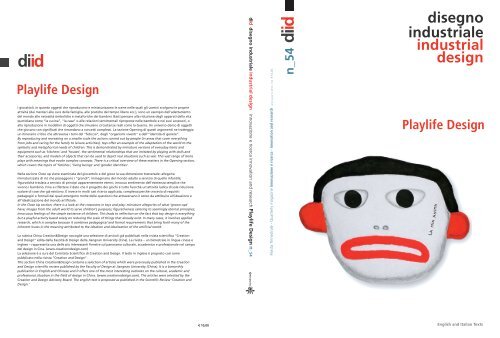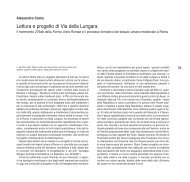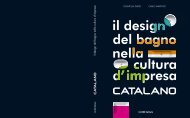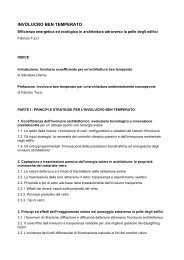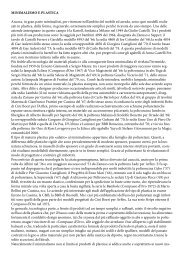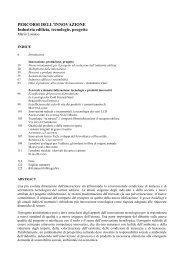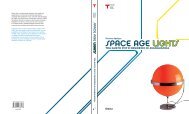Mostra/Apri - Facoltà di Architettura - Sapienza
Mostra/Apri - Facoltà di Architettura - Sapienza
Mostra/Apri - Facoltà di Architettura - Sapienza
Create successful ePaper yourself
Turn your PDF publications into a flip-book with our unique Google optimized e-Paper software.
COPERTADIID54_copertina 13 copia_sab 27/06/12 11.24 Pagina 1<br />
<strong>di</strong>id<br />
Playlife Design<br />
I giocattoli, in quanto oggetti che riproducono e miniaturizzano le scene nelle quali gli uomini svolgono le proprie<br />
attività (dai mestieri alle cure della famiglia, alle pratiche del tempo libero ecc.), sono un esempio dell’adattamento<br />
del mondo alle necessità simboliche e metaforiche dei bambini. Basti pensare alla riduzione degli apparati della vita<br />
quoti<strong>di</strong>ana come “la cucina”, “la casa” o alle relazioni sentimentali riproposte nelle bambole e nei suoi accessori, o<br />
alla riproduzione in modellini <strong>di</strong> oggetti che simulano circostanze reali come la Guerra. Un universo denso <strong>di</strong> oggetti<br />
che giocano con significati che rimandano a concetti complessi. La sezione Opening <strong>di</strong> questi argomenti ne tratteggia<br />
un itinerario critico che attraversa i temi del “feticcio”, degli “organismi viventi” e dell’”identità <strong>di</strong> genere”.<br />
By reproducing and recreating on a smaller scale the actions carried out by people (in areas that cover everything<br />
from jobs and caring for the family to leisure activities), toys offer an example of the adaptation of the world to the<br />
symbolic and metaphorical needs of children. This is demonstrated by miniature versions of everyday items and<br />
equipment such as ‘kitchens’ and ‘houses’, the sentimental relationships that are imitated by playing with dolls and<br />
their accessories, and models of objects that can be used to depict real situations such as war. This vast range of items<br />
plays with meanings that evoke complex concepts. There is a critical overview of these matters in the Opening section,<br />
which covers the topics of ‘fetishes’, ‘living beings’ and ‘gender identities’.<br />
Nella sezione Close up viene esaminata del giocattolo e del gioco la sua <strong>di</strong>mensione trasversale: allegoria<br />
miniaturizzata <strong>di</strong> ciò che posseggono i “gran<strong>di</strong>”; immaginario del mondo adulto a servizio <strong>di</strong> quello infantile;<br />
figuratività traslata a servizio <strong>di</strong> principi apparentemente eterni; innocuo sentimento dell’esistenza semplice che<br />
vivono i bambino. Fino a riflettere il dato che il progetto dei giochi è tutto fuorché un’attività lu<strong>di</strong>ca <strong>di</strong> sola riduzione<br />
scalare <strong>di</strong> cose che già esistono. È invece in molti casi ricerca applicata, complessa perché crocevia <strong>di</strong> requisiti<br />
pedagogici e formali dai quali emergono molte delle questioni che attraversano il senso da attribuire all’ideazione e<br />
all’idealizzazione del mondo artificiale.<br />
In the Close Up section, there is a look at the crossovers in toys and play: miniature allegories of what ‘grown-ups’<br />
have; images from the adult world to serve children’s purposes; figurativeness catering to seemingly eternal principles;<br />
innocuous feelings of the simple existence of children. This leads to reflection on the fact that toy design is everything<br />
but a playful activity based solely on reducing the scale of things that already exist. In many cases, it involves applied<br />
research, which is complex because it combines pedagogical and formal requirements that bring forth many of the<br />
inherent issues in the meaning attributed to the ideation and idealization of the artificial world.<br />
La rubrica China Creation&Design raccoglie una selezione <strong>di</strong> articoli già pubblicati nella rivista scientifica “Creation<br />
and Design” e<strong>di</strong>ta dalla <strong>Facoltà</strong> <strong>di</strong> Design della Jiangnan University (Cina). La rivista – un bimestrale in lingua cinese e<br />
inglese – rappresenta una delle più interessanti finestre sul panorama culturale, accademico e professionale nel campo<br />
del design in Cina. (www.creationndesign.com)<br />
La selezione è a cura del Comitato Scientifico <strong>di</strong> Creation and Design. Il testo in inglese è proposto così come<br />
pubblicato nella rivista “Creation and Design”.<br />
This section China Creation&Design contains a selection of articles which were previously published in the Creation<br />
and Design scientific review published by the Faculty of Design at Jiangnan University (China). It is a bimonthly<br />
publication in English and Chinese and it offers one of the most interesting outlooks on the cultural, academic and<br />
professional situation in the field of design in China. (www.creationndesign.com). The articles were selected by the<br />
Creation and Design Advisory Board. The english text is proposed as published in the Scientific Review ‘Creation and<br />
Design.’<br />
€ 10,00<br />
<strong>di</strong>id <strong>di</strong>segno industriale industrial design innovazione e ricerca innovation and research Playlife Design n_54<br />
Rivista Trimestrale - Quarterly magazine innovazione e ricerca - innovation and research anno | year X, 2012 n.54 € 10,00<br />
<strong>di</strong>id<br />
n_54<br />
<strong>di</strong>segno<br />
industriale<br />
industrial<br />
design<br />
Playlife Design<br />
English and Italian Texts
“Diid | <strong>di</strong>segno industriale_industrial design. Innovazione e Ricerca”,<br />
è la rivista trimestrale <strong>di</strong> approfon<strong>di</strong>mento, che ha come focus la ricerca e<br />
la sperimentazione nel design e che affronta, in ogni numero affronta, un<br />
argomento centrale del <strong>di</strong>battito sul design per esplorarne le relazioni con<br />
la contemporaneità attraverso un’indagine teorica, che si sviluppa nella<br />
sezione Opening e Designer ed attraverso approfon<strong>di</strong>menti e dossier, che si<br />
sviluppano nella sezione Close up. Infine nella rubrica China & Creation, Diid<br />
ospita una selezione <strong>di</strong> articoli tratti dall’omonima rivista cinese che, a sua<br />
volta, pubblica articoli selezionati da Diid.<br />
La selezione degli articoli pubblicati in Diid, prevede la procedura <strong>di</strong> revisione<br />
e valutazione da parte <strong>di</strong> un Comitato <strong>di</strong> Referee (blind peer review). Ciascun<br />
articolo viene sottoposto all’attenzione <strong>di</strong> almeno due Revisori selezionati<br />
in base alle specifiche competenze. I nomi dei revisori vengono resi noti<br />
nell’ultimo numero dell’anno (ott | <strong>di</strong>c). Per l’anno 2011 la procedura<br />
<strong>di</strong> lettura e valutazione è stata affidata agli Associate E<strong>di</strong>tors, secondo le<br />
specifiche competenze. La rivista, in inglese e in italiano, è <strong>di</strong>stribuita nelle<br />
più importanti librerie in Europa, negli Stati Uniti e in Canada. Diid è nata nel<br />
2002 ed è on-line su: www.<strong>di</strong>segnoindustriale.net<br />
‘Diid | <strong>di</strong>segno industriale_industrial design. Innovation and Research’, is<br />
an industrial design quarterly Magazine focusing on design research and<br />
design experimentation. In every single issue, Diid explores a central topic of<br />
the debate on design for investigating its relationship with contemporaneity by<br />
theoretical investigation, which develops in the Opening and Designer section,<br />
and through in-depth and dossiers, which develop in the Close up section. In<br />
the section China & Creation, Diid hosts a selection of articles adapted from<br />
Chinese magazine that, at the same time, publishes selected articles from Diid.<br />
The articles published in Diid are examined and assessed by a blind peer<br />
review. Each article is examined by at least two Referees, chosen accor<strong>di</strong>ng<br />
to their specific field of competence. The names of the Referees are published<br />
every year in the last issue of the Magazine (oct | dec). The 2011 examination<br />
and assessment of the artiche was carried out by the Associate E<strong>di</strong>tors, in<br />
accordance with the specific skills. The magazine in English and Italian is<br />
<strong>di</strong>stributed in Europe, the United States and Canada as well as in major<br />
bookshops. Diid born in 2002 and is on-line on: www.<strong>di</strong>segnoindustriale.net<br />
In copertina | cover:<br />
E. Sottsass, Maschera “La mia anima”, ceramica, 2007<br />
Per gentile concessione della Galleria Clio Calvi Rudy Volpi, Milano.<br />
Ettore Sottsass, ‘La mia anima’ mask, pottery, 2007<br />
By kind permission of the Clio Calvi Rudy Volpi Gallery in Milan.<br />
<strong>di</strong>id_<strong>di</strong>segno industriale industrial design<br />
Rivista trimestrale | Quarterly Magazine<br />
Direttore | Director<br />
Tonino Paris, Full Professor, Head of DATA department | <strong>Sapienza</strong> University of Rome,<br />
via Flaminia 70, 00196 Rome, Italy (tonino.paris@uniroma1.it)<br />
Comitato scientifico e Referees | Associate E<strong>di</strong>tors<br />
Alfonso Acocella, Full Professor | Ferrara University, Italy (alfonso.acocella@unife.it)<br />
Achille Bonito Oliva, Art Critic | Rome, Italy (achillebonitooliva@gmail.com)<br />
Andrea Branzi, Designer, Architect | Milan, Italy (abranzi@tin.it)<br />
Medardo Chiapponi, Full Professor, Dean | IUAV University of Venice, Italy (medardo@iuav.it)<br />
Raul Cunca, Associate Professor, Dean of Design de Equipamento | Universidade de Lisboa,<br />
Lisboa, Portugal (raul.cunca@fba.ul.pt)<br />
Arturo dell’Acqua Bellavitis, Full Professor, Dean | Politecnico <strong>di</strong> Milano, Italy<br />
(arturo.dellacqua@ceda.polimi.it)<br />
Alpay Er, PhD, Full Professor, Head of Department of Industrial Product Design | ITU Istanbul<br />
Technical University, Istanbul, Turkey (alpayer@itu.edu.tr)<br />
Stefano Giovannoni, Designer, Architect | Milan, Italy (stefano@stefanogiovannoni.it)<br />
Miaosen Gong, PhD Associate Professor, Assistant Dean | School of Design, Jangnan University,<br />
Wuxi, China (miaosen.gong@gmail.com)<br />
Takayuki Higuchi, PhD, Associate Professor | Graduate School of Engineering Department of<br />
Design Science, Chiba University, Chiba, Japan (thiguchi@faculty.chiba-u.jp)<br />
Lorenzo Imbesi, Associate Professor | Carleton University’s School of Industrial Design, Ottawa,<br />
Canada (lorenzo_imbesi@carleton.ca)<br />
Stefano Marzano, Designer, Architect, Advisory Board ID Chairman | Eindhoven Technical<br />
University, Eindhoven, Holland (stefano.marzano@philips.com)<br />
Eero Miettenen, Professor of Industrial Design and International Product Development | School of<br />
Art and Design Aalto University Department of Design, Helsinki, Finland (eero.miettinen@aalto.fi)<br />
Mario Morcellini, Full Professor, Dean | <strong>Sapienza</strong> University of Rome, Italy<br />
(mario.morcellini@uniroma1.it)<br />
Kuno Prey, Full Professor | Free University of Bozen, Bozen Italy (kuno.prey@unibz.it)<br />
Patrizia Ranzo, Full professor | SUN Second University of Naples, Naples, Italy<br />
(cappellieranzo@usa.net)<br />
Maria Benedetta Spadolini, Full Professor, Dean | University of Genoa, Genoa, Italy<br />
(spadol@leonardo.arch.unige.it)<br />
Redazione | E<strong>di</strong>torial Board<br />
caporedattore | E<strong>di</strong>tor-in-Chief<br />
Sabrina Lucibello, Phd Researcher Professor in Design | <strong>Sapienza</strong> University of Rome, Rome,<br />
Italy (sabrina.lucibello@uniroma1.it)<br />
Cecilia Cecchini, Associate Professor | <strong>Sapienza</strong> University of Rome, Rome, Italy<br />
(cecilia.cecchini@uniroma1.it)<br />
Vincenzo Cristallo, Phd Researcher Professor in Design | <strong>Sapienza</strong> University of Rome, Rome,<br />
Italy (vincenzo.cristallo@uniroma1.it)<br />
Federica Dal Falco, Associate Professor | <strong>Sapienza</strong> University of Rome, Rome, Italy<br />
(federica.dalfalco@uniroma1.it)<br />
Loredana Di Lucchio Phd Researcher Professor in Design | <strong>Sapienza</strong> University of Rome,<br />
Rome, Italy (loredana.<strong>di</strong>lucchio@uniroma1.it)<br />
Carlo Martino, Phd Researcher Professor in Design | <strong>Sapienza</strong> University of Rome, Rome, Italy<br />
(carlo.martino@uniroma1.it)<br />
Corrispondenti | Foreign correspondents<br />
Genoa, Italy: Raffaella Fagnoni, Phd Researcher Professor in Design | University of Genoa<br />
(raffaella.fagnoni@isiadesign.fi.it)<br />
Naples, Italy: Francesca La Rocca, Phd Researcher Professor in Design | SUN Second University<br />
of Naples (francesca.larocca@unina2.it)<br />
Venice, Italy: Raimonda Riccini, Associate Professor | IAUV University of Venice (raimonda@iuav.it)<br />
Milan, Italy: Francesco Zurlo, Associate Professor | Politecnico <strong>di</strong> Milano (francesco.zurlo@polimi.it)<br />
Segreteria <strong>di</strong> redazione | E<strong>di</strong>torial Headquarter<br />
Luciana Ampani, Via Flaminia 70, 00196 Roma c/o <strong>di</strong>p.D.A.T.A<br />
tel. +39 (0)6 49919020 - 94 | fax. +39 (0)6 49919015<br />
www.<strong>di</strong>segnoindustriale.net | rdesignpress@rdesignpress.it<br />
Progetto grafico | Art <strong>di</strong>rection<br />
Paola Schiattarella<br />
Impaginazione | Production<br />
Laboratorio <strong>Sapienza</strong> Design Factory<br />
Traduzione | Translations<br />
Clau<strong>di</strong>a Vettore<br />
Fondata da | Founded by<br />
Tonino Paris<br />
Registrazione presso il Tribunale <strong>di</strong> Roma 86/2002 del 6 marzo 2002 | Registered in Rome-,<br />
Italy ISSN: 1594-8528 anno / year X, 2012 n.54, Apr | Jun<br />
E<strong>di</strong>tore | Publisher<br />
Rdesignpress, Roma | www.rdesignpress.it (rdesignpress@rdesignpress.it)<br />
Distribuzione librerie | Distribution through bookstores<br />
Joo <strong>di</strong>stribution, Via Filippo Argelati 35, 20143, Milano<br />
tel. +39 (0)2 8375671 | fax. +39 (0)2 58112324, www.joo<strong>di</strong>stribuzione.it | info@joo<strong>di</strong>stribuzione.it<br />
Distribuzione estero | Distribution for other countries<br />
SO.DI.P. SpA, Via Bettola 18, 20092 Cinisello Balsamo (MI)<br />
Tel. +39 (0)2 66030400 | fax. +39 (0)2 66030269, www.siesnet.it | sies@siesnet.it<br />
Concessionaria pubblicità | Concessionary agent for advertising<br />
Roma designpiu srl fax. +39 (0)6 49919015,<br />
www.romadesignpiu.it | rdesignpress@rdesignpress.it<br />
Stampa | Printing<br />
Tipografia Ceccarelli, via Grotte <strong>di</strong> Castro, 01025 Viterbo<br />
tel. +39 (0)763 796029 | fax. +39 (0)763 797230 www.tipografiaceccarelli.it<br />
index<br />
4<br />
8<br />
14<br />
20<br />
26<br />
34<br />
40<br />
46<br />
52<br />
58<br />
68<br />
EDITORIAL<br />
Tonino Paris<br />
Il giocattolo come oggetto del desiderio | Toys as Objects of Desire<br />
PLAYLIFE DESIGN<br />
opening<br />
Massimo Fusillo | Francesca La Rocca<br />
Animare gli oggetti: il valore del feticcio tra arti, gioco e design | Animating Objects: the Value of the Fetish in<br />
Arts, Games and Design<br />
Federica Dal Falco<br />
Automi, simulazioni degli organismi viventi | Automata: Synthetic Living Beings<br />
Sabrina Lucibello<br />
Giocattoli performanti tra vecchie storie e nuovi materiali | Old Stories and new Materials for Performing Toys<br />
designer<br />
Lucia Pietroni<br />
Il design del giocattolo e l’identità <strong>di</strong> genere | Toy Design and Gender Identity<br />
CLOSE UP<br />
innovation&research<br />
Cecilia Cecchini<br />
XXSmall: la miniaturizzazione del quoti<strong>di</strong>ano | XXSmall: The Miniaturisation of Everyday Life<br />
Arianna Vignati<br />
Progettare un gioco non è un gioco | Designing a Toy is not a Child’s Play<br />
Raffaella Fagnoni<br />
Care Toys<br />
case history<br />
Lorenzo Imbesi<br />
How to Design an American Girl<br />
thinking about...<br />
Keneilwe Munyai | Mugen<strong>di</strong> K. M’Rithaa<br />
Il design del giocattolo tra<strong>di</strong>zionale una prospettiva sudafricana | Tra<strong>di</strong>tional Toy Design: a South African Perspective<br />
CHINA CREATION & DESIGN<br />
Feng Shu<br />
Una nuova <strong>di</strong>dattica per un Design dell’integrazione | New Design Education towards Integrated Design
1.<br />
34<br />
CLOSE UP | innovation&research<br />
Cecilia Cecchini 1<br />
XXSmall: la miniaturizzazione del quoti<strong>di</strong>ano<br />
XXSmall: The Miniaturisation of Everyday Life<br />
keywords: miniaturisation |toys| simulation of phenomena | modelling | new materials<br />
I giocattoli <strong>di</strong> ultima generazione miniaturizzano il paesaggio domestico, soprattutto nell’ambito<br />
delle cucine, simulando con materiali performanti, artifici tecnici o semplici accorgimenti scenici,<br />
le funzioni degli elettrodomestici originali, con stupefacente verosimiglianza: acqua che sembra<br />
bollire nelle mini-pentole poggiate su piani in vetroceramica che paiono accesi; aspirapolveri<br />
ergonomici completi <strong>di</strong> spazzole girevoli che aspirano con grande potenza; ferri da stiro che<br />
nebulizzano acqua; lavatrici con cestelli rotanti che riproducono i suoni del lavaggio e imitano<br />
il controllo elettronico con <strong>di</strong>splay retroilluminati; mini pannelli solari che accendono i led per<br />
illuminare la cucina... Tutto formato small.<br />
In questo mondo lillipuziano tra plastiche, cromature, membrane elastiche, materiali<br />
termocromatici resistono i giochi in legno massello, i piccoli elettrodomestici total wood non<br />
hanno alcuna prestazione, ma a questa mancanza può supplire la fantasia dei bambini.<br />
L’adultizzazione del mondo infantile e la conseguente imitazione delle azioni dei gran<strong>di</strong> da parte<br />
dei bambini sono, fin dall’antichità, capisal<strong>di</strong> del gioco. In molti casi la miniaturizzazione degli<br />
oggetti a scopo lu<strong>di</strong>co è stata accompagnata dalla simulazione, più o meno veritiera, del loro<br />
funzionamento. Per chi era bambino negli anni ’60 uno dei massimi pro<strong>di</strong>gi, alla portata <strong>di</strong> tutte<br />
le tasche, era il piccolo biberon <strong>di</strong> plastica per dare il latte alle bambole: inclinandolo il liquido<br />
bianco spariva. Oggi questo semplice quanto magico artificio fa sorridere se confrontato con<br />
i <strong>di</strong>spositivi che corredano i giocattoli, in particolare nell’ambito della miniaturizzazione degli<br />
scenari domestici. L’imitazione della realtà e la simulazione dei fenomeni è sempre più spinta,<br />
favorita dall’impiego <strong>di</strong> materiali avanzati, tecnologie performanti o semplici accorgimenti scenici.<br />
Il massimo della sofisticazione si trova nelle copie in scala ridotta degli elettrodomestici casalinghi<br />
e nelle superaccessoriate cucine - destinate a tecnologiche massaie in erba e non <strong>di</strong>sdegnate<br />
neanche dai maschi - che riproducono il funzionamento dei modelli cui si ispirano. O lo simulano<br />
in con<strong>di</strong>zione <strong>di</strong> sicurezza, nel rispetto dalle stringenti normative vigenti in materia.<br />
Nelle cucine in miniatura il rubinetto eroga davvero un filo <strong>di</strong> acqua; la cappa motorizzata<br />
non aspira ma riproduce perfettamente il fasti<strong>di</strong>oso rumore; il frigorifero non raffredda, ma la<br />
circolazione dell’aria al suo interno è assicurata da una ventola rotante; mini-fruste arrotondate <strong>di</strong><br />
un frullatore ultimo modello sono in grado <strong>di</strong> impastare minuscole porzioni <strong>di</strong> farina.<br />
Il prossimo passo? Il bollore dell’acqua in una mini-pentola: non sarà vero, ma alzando il minicoperchio<br />
con mini-presine (queste sì inutili, ma non tarderà neanche la pentola conduttrice <strong>di</strong><br />
un calore immaginario) si faticherà a capire che quel su e giù <strong>di</strong> bollicine non è dovuto al naturale<br />
raggiungimento dei 100 C°, ma al sapiente impiego <strong>di</strong> membrane elastiche semitrasparenti,<br />
azionate da invisibili mini-molle a batteria, che producono anche un rumore simil-bollore.<br />
Anche il funzionamento dei fuochi è simulato con impressionante verosimiglianza, altro che<br />
tremolio dei piccoli falò nei presepi! Grazie all’effetto combinato <strong>di</strong> luci e suoni “le pentole a<br />
contatto dei fornelli sfrigolano come quelle vere”, si legge in una pubblicità <strong>di</strong> cucine giocattolo.<br />
E non potevano mancare i piani cottura retroilluminati che mimano quelli in vetroceramica, tanto<br />
per non restare in<strong>di</strong>etro con l’imitazione dell’evoluzione tecnologica.<br />
In questa wonderland domestica non mancano gli intenti <strong>di</strong>dattici: i portarifiuti organizzati a<br />
scomparti separati abituano i bambini alla raccolta <strong>di</strong>fferenziata; i programmi Eco delle mini<br />
lavatrici insegnano a limitare il consumo dell’acqua; i piccoli pannelli solari orientabili montati sui<br />
3.<br />
tetti delle case delle bambole accendono le luci a led nelle <strong>di</strong>verse<br />
stanze, mostrando così l’efficienza delle energie alternative ai<br />
futuri citta<strong>di</strong>ni. Che saranno probabilmente superconsumisti ma,<br />
speriamo, almeno ambientalmente consapevoli.<br />
Anche la sollecitazione dei sensi è a tutto tondo. Non solo la<br />
vista, l’u<strong>di</strong>to e il tatto, ma anche l’olfatto entra in gioco, proprio<br />
come nelle più avanzate tendenze del design contemporaneo.<br />
Nelle mini-<strong>di</strong>spense perfette riproduzioni in scala <strong>di</strong> cibi emanano<br />
odori <strong>di</strong> vanillina, fragola, cioccolato, caffè, affumicatura e anche<br />
i profumi del panettone e del pandoro, per non scontentare<br />
nessuno. Infatti le paste sintetiche con le quali sono realizzate le<br />
piccole pietanze possono essere facilmente ad<strong>di</strong>zionate con aromi<br />
artificiali che resistono nel tempo anche dopo ripetuti lavaggi,<br />
essendo inglobati nella massa del materiale prima della formatura.<br />
E così via miniaturizzando. C’è il Vorwerk Folletto funzionante a<br />
pile perfettamente identico all’aspirapolvere originale, anche lui<br />
dotato <strong>di</strong> “interruttore, manico estraibile e filtro smontabile”;<br />
la lavabiancheria con cestello rotante che riproduce i suoni del<br />
lavaggio e imita il controllo elettronico con il <strong>di</strong>splay retroilluminato;<br />
il mini ferro da stiro con nebulizzatore d’acqua; la macchina per<br />
preparare la mini-pasta fatta in casa con sette <strong>di</strong>fferenti trafile<br />
perché “... che italiani saremmo senza la pasta”? La mini-gelatiera<br />
completa <strong>di</strong> “<strong>di</strong>spenser per la glassa” che produce veri gelati; il<br />
tostapane per mini-sandwich che saltano fuori una volta dorati,<br />
come nei film americani degli anni Cinquanta che mostravano i<br />
nuovi pro<strong>di</strong>gi domestici.<br />
In alcuni casi sono gli stessi produttori <strong>di</strong> cucine e <strong>di</strong><br />
elettrodomestici ad avere una linea de<strong>di</strong>cata ai bambini. Talvolta i toys sono <strong>di</strong>versi dagli originali<br />
- è il caso delle piccole cucine Scavolini - talaltra sono uguali, solo in formato small. Come gli<br />
elettrodomestici Miele - gran<strong>di</strong> circa 30 cm - che non hanno nulla da invi<strong>di</strong>are a quelli veri:<br />
nell’oblò cromato della lavatrice si può anche lavare con un po’ <strong>di</strong> acqua; il forno a microonde ha<br />
il piatto rotante e il <strong>di</strong>splay a led; l’aspirapolvere cattura con grande potenza in un sacchetto in<br />
tessuto svuotabile le palline <strong>di</strong> polistirolo, in dotazione.<br />
Così, abituati fin dalla tenera età a tali prestazioni e cura dei dettagli, è <strong>di</strong>fficile non rimanere<br />
fidelizzati a vita, infatti il marchio sui giocattoli, è stampato bene in vista. Ma la miniaturizzazione<br />
dei propri prodotti ha illustri precedenti, già Michael Thonet inserì nella sua produzione i mobili<br />
per l’infanzia in faggio curvato, identici a quelli per adulti.<br />
Nel lillipuziano universo domestico dei giocattoli tra plastiche, cromature e led resiste il legno,<br />
anche quello massello. Le prestazioni degli elettrodomestici non sono altrettanto avanzate,<br />
anzi non ci sono proprio, ma a questa mancanza può supplire la fantasia dei bambini.<br />
Appartiene alla famiglia total wood il mini tostapane che, ovviamente, non tosta, ma dal quale<br />
manualmente, con un mini-pomello, il bambino può far uscire due piccoli pannelli <strong>di</strong> legno a<br />
forma toast, bruniti a puntino: una cottura perpetua che, in mezzo a tanti tecnologici artifici,<br />
fa grande tenerezza. Della stessa linea la mini-macchinetta del caffè espresso, che ha <strong>di</strong> legno<br />
(1) Cecilia Cecchini, Professore Associato, “<strong>Sapienza</strong>” Università<br />
<strong>di</strong> Roma, <strong>Facoltà</strong> <strong>di</strong> <strong>Architettura</strong>, Dipartimento DATA,<br />
sezione Design.<br />
Cecilia Cecchin, Associate Professor, “<strong>Sapienza</strong>” University of<br />
Rome, Faculty of Architecture, DATA Department, Design Sector.<br />
cecilia.cecchini@uniroma1.it<br />
1. Rise’n Shine, macchinetta per il caffè | coffee maker, Orso<br />
Poeta Giocattoli.<br />
2. Forno a microonde giocattolo, Miele Pedagogic Line.<br />
Alimentazione a batteria, illuminazione interna, led, piatto rotante.<br />
Microwave oven, Miele ‘Pedagogic Line’.<br />
Battery operated, internal lighting, LED and rotating plate.<br />
3. Lavabiancheria giocattolo, Miele Pedagogic Line. Cestello rotante<br />
con acqua, simulazione acustica lavaggio, pannelli coman<strong>di</strong><br />
illuminato.<br />
Toy washing machine, Miele ‘Pedagogic Line’. Rotating drum with<br />
water, wash simulation sounds and illuminated control panel.<br />
2.
4.<br />
36<br />
CLOSE UP | innovation&research<br />
anche la cialda e il contenitore del latte: ovvio, per macchiare<br />
l’immaginario caffè. Per essere al passo con i tempi ha anche<br />
l’orologio a led incorporato con i tipici numeri a segmenti, ma è<br />
<strong>di</strong>segnato, per sempre immobile sulle 8.00.<br />
Oggi, come accennato, le normative relative ai giochi per i bambini<br />
impongono livelli <strong>di</strong> sicurezza molto alti, <strong>di</strong> conseguenza nel<br />
panorama dei mini-elettrodomestici la funzione cottura essendo la<br />
più rischiosa è, salvo rare eccezioni, simulata, talvolta con grande<br />
verosimiglianza. Ma non è sempre stato così.<br />
Agli inizi degli anni ‘70 la Harbert sas – dal nome straniero, ma in<br />
realtà <strong>di</strong> Milano – produsse “Dolce forno”. Appena apparve la sua<br />
réclame su Topolino questo giocattolo dal colorato aspetto lu<strong>di</strong>co<br />
ma funzionante veramente, occupò stabilmente la prima posizione<br />
nelle letterine <strong>di</strong> Natale della maggior parte delle bambine.<br />
Era, infatti, una vera innovazione nel mondo dei giocattoli: grazie al<br />
calore <strong>di</strong> due lampa<strong>di</strong>ne a incandescenza da 100 watt, poi sostituite<br />
con quelle da 60 watt, cuoceva i piccoli dolci che si potevano<br />
realizzare secondo il mini ricettario allegato, utilizzando ciotoline,<br />
formine, misurino e mattarello, sempre in dotazione. Le lampa<strong>di</strong>ne<br />
erano sostituibili grazie all’utilizzo dell’apposita chiave a brugola,<br />
rigorosamente “da consegnare ai genitori”. Questa azienda fu per<br />
un ventennio la fucina dei desideri dei bambini 2 , tra i tanti giocattoli<br />
produsse: “Dolce gelato” che, azionato a manovella, raffreddava<br />
creme a base <strong>di</strong> latte e frutta grazie a un cilindro metallico riempito<br />
<strong>di</strong> ghiaccio e sale; “Dolce pastamatic” completa <strong>di</strong> varie trafile<br />
per estrudere la pasta secondo varie forme; “Dolce bon bon” per<br />
preparare caramelle e gelatine; “Dolce zucchero filato”... Insomma,<br />
rispondeva a tutti i bisogni dei piccoli chef e ne induceva <strong>di</strong> sempre<br />
nuovi. Dal canto suo Giochi Preziosi, che nel 1994 acquisì l’azienda Harbert, rispose con una<br />
<strong>di</strong>versa filosofia, quella della simulazione: lanciò sul mercato “Friggi friggi”, una bistecchiera che<br />
non cuoceva veramente, ma sulla quale simil-bistecche e simil-hamburger si scurivano, come<br />
magicamente rosolate, nel giro <strong>di</strong> qualche minuto. Strofinandole poi tra le mani tornavano<br />
al colore rosa precottura, infatti il materiale con il quale erano realizzate le finte pietanze a<br />
contatto con il calore riacquistava l’aspetto originario. Si tratta <strong>di</strong> uno dei primi esempi dell’uso<br />
<strong>di</strong> materiale termocromatico nei giochi dei bambini, foriero, come abbiamo visto, <strong>di</strong> un grande<br />
futuro <strong>di</strong> simulazioni.<br />
(2) La Harbert sas era una delle maggiori aziende italiane <strong>di</strong> giocattoli.<br />
Ha inventato nuove tipologie <strong>di</strong> giochi che in molti casi hanno<br />
fatto scuola, come il “Festacolor” che proiettava sette <strong>di</strong>apositive<br />
unite in un’unica striscia <strong>di</strong> cartone, prevalentemente con storie<br />
della Walt Disney, da far scorrere manualmente. Applicò al mondo<br />
dei giocattoli nuove tecnologie - come nel caso del gioco da tavolo<br />
nel quale un piccolo autobus tramite un sensore riusciva a percorrere<br />
una strada - e sfruttò con maestria le prestazioni dei materiali<br />
come nel caso delle membrane elastiche riempite <strong>di</strong> una specie <strong>di</strong><br />
gel per la realizzazione <strong>di</strong> “Mister Muscolo”, il pupazzo che poteva<br />
essere allungato a piacere e riprendeva le <strong>di</strong>mensioni originarie.<br />
4.5. Rosalie, Small Foot Company 1522. Cucinotto in legno con<br />
sportelli apribili, manopole girevoli, in dotazione cibi e stoviglie.<br />
Rosalie cooker, Small Foot Company 1522. Wooden cooker<br />
with doors that open, rotating handle, food and pans supplied.<br />
ENGLISH TEXT<br />
Latest generation toys have created a miniature home environment, especially as regards the<br />
kitchen, using high performance materials, technical devices or simple effects to reproduce<br />
incre<strong>di</strong>bly lifelike functions of home appliances: water appears to boil in mini-pans on glass-<br />
ceramic hobs that seem lit, ergonomic vacuum cleaners complete with rotating brushes offer<br />
powerful suction, irons have a steam effect, washing machines with rotating drums produce the<br />
5.<br />
sounds of a wash and imitate the control panel with backlit <strong>di</strong>splays, while mini solar panels light<br />
up LEDs to illuminate the kitchen... all in small-size.<br />
In this Lilliputian world of plastic, chrome, elastic membranes and thermochromatic materials<br />
there are still solid wood toys – little household appliances made completely of wood, where a<br />
child’s imagination makes up for the lack of high performance functions.<br />
The adultisation of childhood and children imitating adult actions have been essential elements<br />
of play since ancient times. In many cases miniaturising objects for play has been accompanied<br />
by a more or less lifelike simulation of their function.<br />
If you were a child in the 1960s one of the greatest marvels – one that everyone could afford<br />
– was a little plastic bottle you used to give your dolls milk. When you tilted it the white liquid<br />
<strong>di</strong>sappeared. Now this simple yet magical effect makes us smile when we compare it to the<br />
devices of toys today, especially those that are miniature versions of home appliances. The<br />
imitation of reality and simulation of phenomena is increasingly realistic and uses advanced<br />
materials, high-tech performance or mere lifelike details.<br />
The height of sophistication are the scaled-down versions of electrical appliances and fully<br />
equipped kitchens – aimed at bud<strong>di</strong>ng baby housewives but also appealing to boys – that<br />
reproduce the functions of the models that inspired them or simulate them safely (in full<br />
compliance with the stringent regulations that govern toys).<br />
In these miniature kitchens the tap really produces water, the motorised hood doesn’t extract air<br />
but reproduces the annoying noise perfectly, the fridge doesn’t cool anything, but a rotating fan<br />
ensures that air circulates inside and mini-beaters with an ultra-modern blender mix tiny portions<br />
of flour. What next? Water boils in a mini-pan - it doesn’t really, but when you lift the mini-lid<br />
with mini-oven gloves (useless, but soon there’ll be a pan that produces imaginary heat) it’s hard<br />
to see that the bubbles rising and falling aren’t the result of water reaching 100 C°, but the<br />
skilful use of a semi-transparent plastic membrane, moved by invisible battery operated minisprings,<br />
which also produces the noise of boiling.<br />
The simulation of the hob burning is also incre<strong>di</strong>bly realistic – nothing like the little flickering<br />
fire in the nativity scene! Thanks to a dual effect of light and sound ‘pans on the stove hiss like<br />
real ones’ (in the words of the advert for one of these toy kitchens). Of course there are also<br />
the backlit oven tops that imitate those in glass-ceramic; nothing is forgotten in the imitation of<br />
technological development.<br />
This domestic wonderland is also inspired by educational motives: the <strong>di</strong>fferent compartments of<br />
the bins help children separate rubbish, and the Eco programmes of the mini-washing machines<br />
teach them not to waste water, the little <strong>di</strong>rectional solar panels on the dolls houses turn on LED<br />
lights in various rooms, demonstrating efficient alternative energy to our future citizens. They will<br />
probably be <strong>di</strong>ehard consumers, but at least, we hope, environmentally aware.<br />
All the sense are stimulated. Not only sight, hearing and touch, but smell also comes into play -<br />
just like in the most recent trends in contemporary design. Food in the mini-cupboards, created<br />
perfectly to scale, emits the scents of vanilla, strawberry, chocolate, wood smoke and even the<br />
fragrance of panettone and pandoro, so there’s something for everyone. In fact, artificial aromas<br />
that resist over time, even after repeated washing, can be easily added to the synthetic pastes<br />
with which these little meals are made, as they are incorporated into the material before it is<br />
moulded. And so the miniaturising goes on. There is a battery operated Kobold vacuum cleaner
6.<br />
38<br />
CLOSE UP | innovation&research<br />
that is completely identical to the original, also with a ‘switch,<br />
extractable handle and removable filter’, the washing machine<br />
with a rotating drum that reproduces the sounds of washing and<br />
imitates the control panel with its backlit <strong>di</strong>splay, the mini steam<br />
iron, the mini-pasta machine with seven <strong>di</strong>fferent settings because<br />
‘... how could we be Italians without pasta?’ The mini-ice cream<br />
maker complete with ‘topping <strong>di</strong>spenser’ that makes real ices, and<br />
the toaster for mini-sandwiches that come out golden, just like<br />
in American films of the 1950s that showed these new domestic<br />
marvels. In some cases the same kitchen and home appliance<br />
manufacturers have a range de<strong>di</strong>cated to children. Sometimes<br />
the toys are <strong>di</strong>fferent from the originals – as with Scavolini’s little<br />
kitchens – they are just in a smaller format. Like Miele home<br />
appliances, 30 cm high and just as sophisticated as the originals: in<br />
the washing machine’s chrome surround drum you can even wash<br />
with a little water, the microwave oven has a rotating <strong>di</strong>sh and a<br />
LED <strong>di</strong>splay, and the vacuum cleaner sucks up the polystyrene balls<br />
supplied into a fabric bag (that you can empty) with great power.<br />
So when kids are used to this kind of performance and attention<br />
to detail at such a young age it is <strong>di</strong>fficult not to remain a loyal<br />
customer for life and, in fact, the brand name is clearly visible on<br />
these toys. However, the miniaturisation of products has some<br />
famous precedents – even Michael Thonet produced children’s<br />
furniture in curved beech that was identical to the adult version.<br />
In this domestic Lilliputian world of toys with their plastic, chrome<br />
and LED details, there are still some made of solid wood. The<br />
performance of these household appliances is not as advanced –<br />
in fact, they don’t perform at all – but a child’s imagination does<br />
the rest. There is a mini toaster completely made of wood that<br />
obviously doesn’t toast bread, but by using a mini knob a child can make two toast-shaped<br />
pieces of wood emerge, browned to perfection. They are perpetually cooked which, in the midst<br />
of all these high tech effects, is extremely touching. In the same range there is a mini espresso<br />
maker, with a wooden capsule and milk jug, which obviously grinds imaginary coffee. To keep up<br />
with the times it even has an incorporated LED clock with typical number segments, but they are<br />
drawn on and remain perpetually fixed at 8 o’clock.<br />
Today, as we have already mentioned, regulations for children’s toys have very high safety<br />
standards; therefore, a ‘cook function’ in mini-household appliances can be dangerous and,<br />
with a few rare exceptions, is simulated in an incre<strong>di</strong>bly realistic way. But this hasn’t always<br />
been the case.<br />
In the early ‘70s Harbert sas – a foreign-soun<strong>di</strong>ng name, but in reality the company was from<br />
Milan – produced a toy called ‘Dolce forno’. As soon as it was advertised in the Mickey Mouse<br />
comic, this colourful, fun, but fully functioning toy was top of the list in little girls’ letters to<br />
Father Christmas. It was a real innovation in the world of toys. Thanks to two incandescent 100<br />
watt (later 60 watt) bulbs, it cooked small cakes that you could make by following the mini-<br />
(2) Harbert sas was a lea<strong>di</strong>ng Italian toy manufacturer. It invented<br />
new types of toys that were often revolutionary, like ‘Festacolor’<br />
that projected seven slides in a single strip of cardboard (usually<br />
Walt Disney stories) and could be moved by hand. It applied new<br />
technology to the world of toys – like the board game where a little<br />
bus ‘drove’ down a street, using a sensor – and was highly skilled<br />
in using the qualities of materials like the elastic membrane filled<br />
with a kind of gel to create ‘Mister Muscolo’, the toy that could be<br />
stretched as you pleased and returned to its original shape.<br />
6.8. Cucina nella valigia “professionale” in legno, Small Foot<br />
Company.<br />
‘Professional’ cooker in a suitcase, Small Foot Company.<br />
7. Tostapane in legno, Small Foot Company 1137 | Wooden toaster,<br />
Small Foot Company 1137.<br />
R: AA.VV. (2011). Exhibition Catalogue, XXSmall Poppenhuizen<br />
en meer in miniatuur, Aja, 12/11/2011-25/3/2012, Gemeentemuseum<br />
Den Haag. Zolle, Netherland: W Books.<br />
Benjamin, W. (2010). Bambini, abbecedari, giocattoli. (A cura <strong>di</strong> S.<br />
Calabrese & A. De Blasio). Bologna, IT: ArchetipoLibri.<br />
recipe book enclosed, using the bowls, moulds, measuring spoons and rolling pin supplied.<br />
The bulb could be changed by using the special allen key of course ‘only by an adult’.<br />
For twenty years this company was a hotbed of children’s dreams 2 and amongst the many toys<br />
it produced there was ‘Dolce gelato’ which, when you turned its handle, cooled milk and fruit<br />
based sauces, thanks to a metal cylinder filled with ice and salt; ‘Dolce pastamatic’ complete<br />
with various moulds for <strong>di</strong>fferent shaped pasta, ‘Dolce bon bon’ for sweets and jellies and ‘Dolce<br />
zucchero filato’ for candyfloss…In short, it fulfilled the needs of all little chefs, and continually<br />
created new ones.<br />
Giochi Preziosi, which took over Harbert in 1994, responded with a <strong>di</strong>fferent philosophy:<br />
simulation. It launched ‘Friggi friggi’, a grill that <strong>di</strong>dn’t really cook, but on which realistic steaks<br />
and hamburgers turned brown, as if magically grilled, in just a few minutes. When you rubbed<br />
them between your hands they returned to their pre-cooked pink colour. In fact, the material<br />
with which these fake meals were made reacquired its original appearance on contact with<br />
heat. It is one of the first examples of the use of thermochromatic material in children’s toys, the<br />
herald, as we have seen, of a great future of simulation.<br />
7. 8.


